Abstract
Phagocytosis of Clostridium difficile by human polymorphonuclear leukocytes (PMNs) and the possible role of the clostridial toxins in this process were investigated. Phagocytosis of C. difficile was independent of aerobiosis and clearly depended on opsonization. Either complement or antibodies to C. difficile could serve as opsonins. Toxigenic strains of C. difficile were more resistant to phagocytosis than were nontoxigenic strains. Pretreatment of PMNs with as much as 10,000 units of toxins from culture filtrates of C. difficile for 2 h had no effect on either the phagocytic activity of PMNs or their viability as determined by trypan blue exclusion. In contrast, treatment of human embryonic intestinal cells with the same amount of toxin under identical conditions resulted in cell death.
Full text
PDF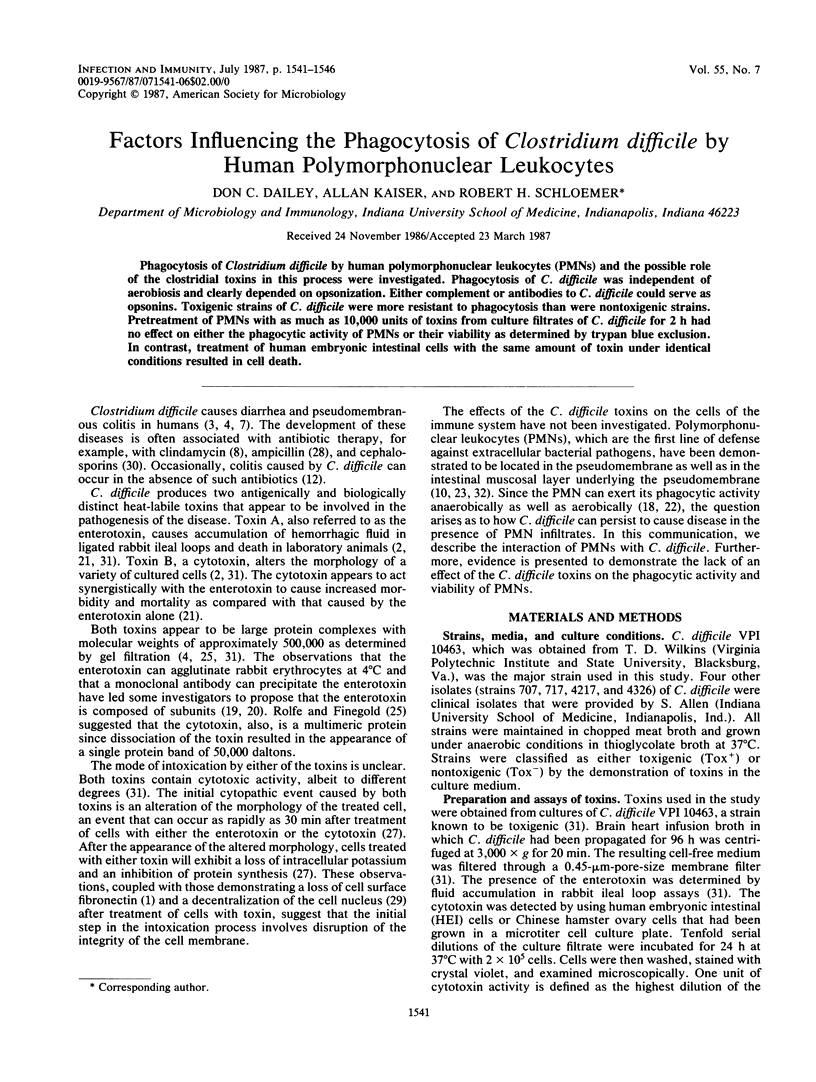

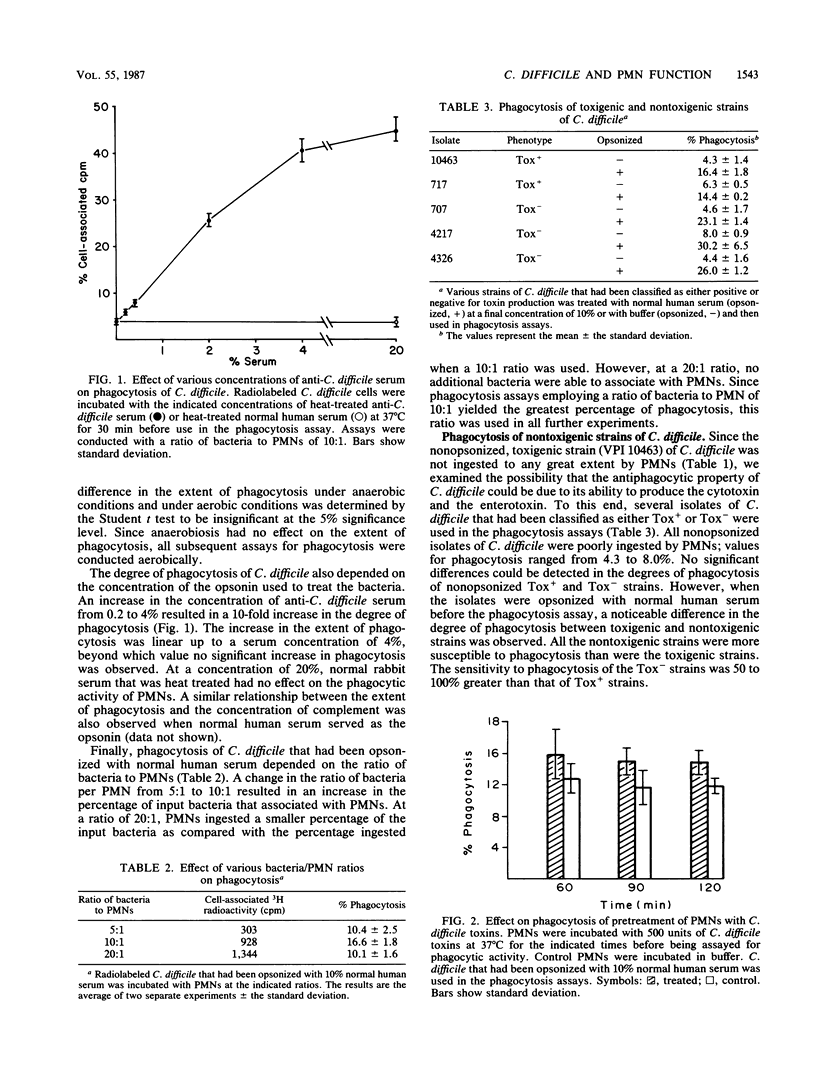
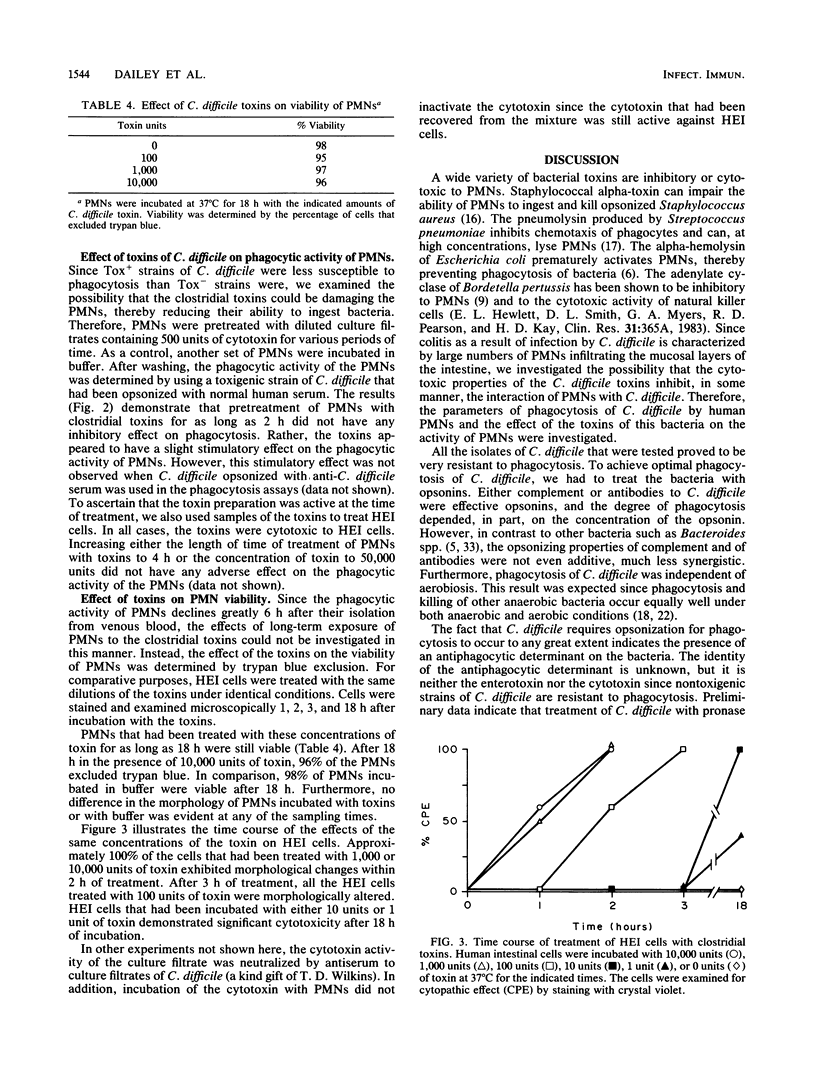
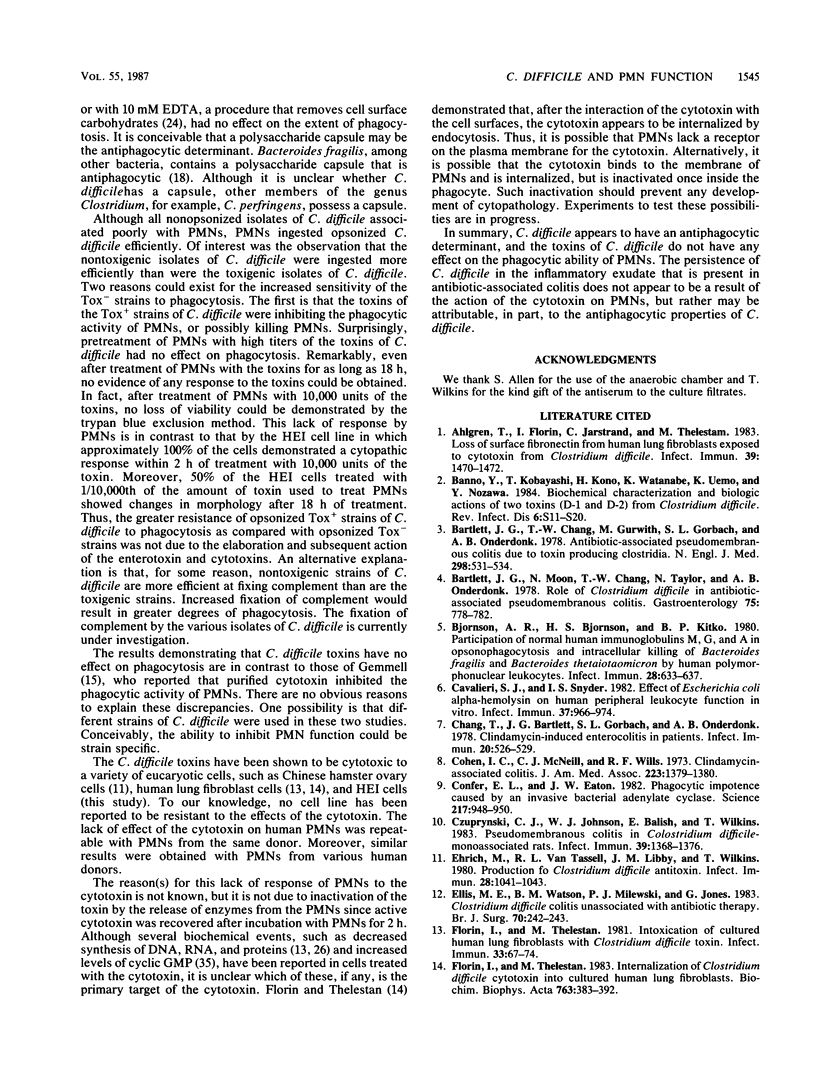
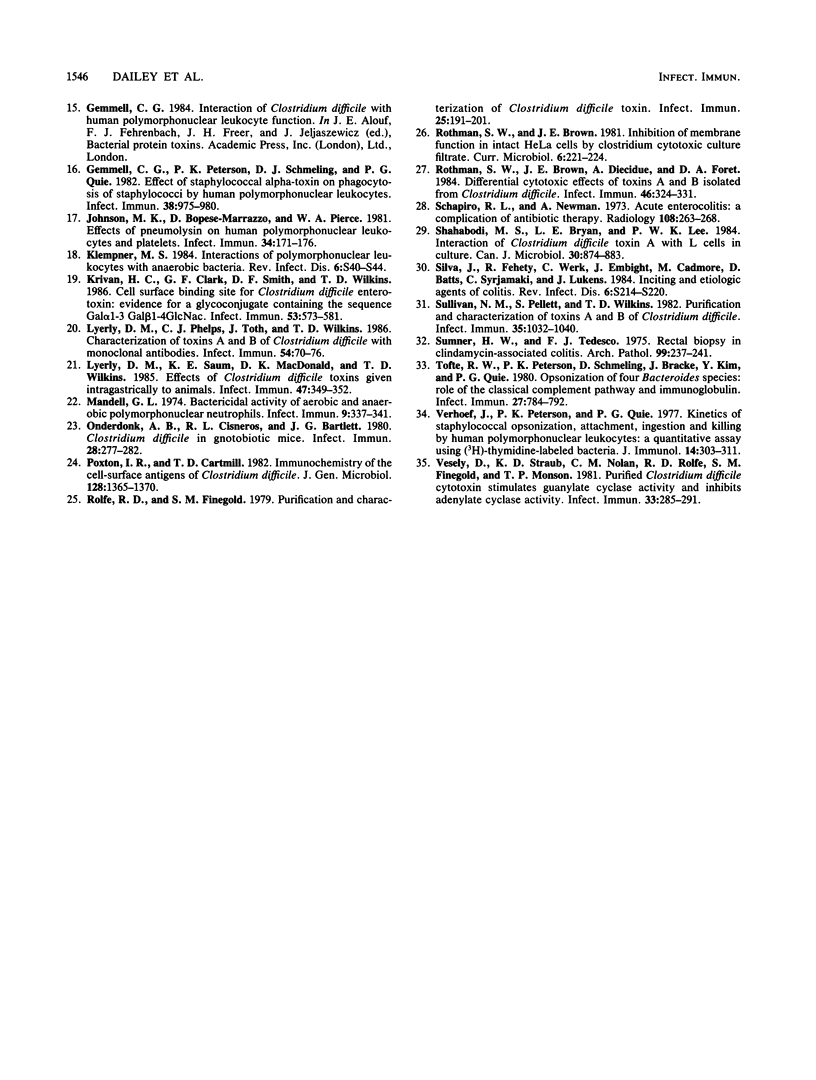
Selected References
These references are in PubMed. This may not be the complete list of references from this article.
- Ahlgren T., Florin I., Jarstrand C., Thelestam M. Loss of surface fibronectin from human lung fibroblasts exposed to cytotoxin from Clostridium difficile. Infect Immun. 1983 Mar;39(3):1470–1472. doi: 10.1128/iai.39.3.1470-1472.1983. [DOI] [PMC free article] [PubMed] [Google Scholar]
- Banno Y., Kobayashi T., Kono H., Watanabe K., Ueno K., Nozawa Y. Biochemical characterization and biologic actions of two toxins (D-1 and D-2) from Clostridium difficile. Rev Infect Dis. 1984 Mar-Apr;6 (Suppl 1):S11–S20. doi: 10.1093/clinids/6.supplement_1.s11. [DOI] [PubMed] [Google Scholar]
- Bartlett J. G., Chang T. W., Gurwith M., Gorbach S. L., Onderdonk A. B. Antibiotic-associated pseudomembranous colitis due to toxin-producing clostridia. N Engl J Med. 1978 Mar 9;298(10):531–534. doi: 10.1056/NEJM197803092981003. [DOI] [PubMed] [Google Scholar]
- Bartlett J. G., Moon N., Chang T. W., Taylor N., Onderdonk A. B. Role of Clostridium difficile in antibiotic-associated pseudomembranous colitis. Gastroenterology. 1978 Nov;75(5):778–782. [PubMed] [Google Scholar]
- Bjornson A. B., Bjornson H. S., Kitko B. P. Participation of normal human immunoglobulins M, G, and A in opsonophagocytosis and intracellular killing of Bacteroides fragilis and Bacteroides thetaiotaomicron by human polymorphonuclear leukocytes. Infect Immun. 1980 May;28(2):633–637. doi: 10.1128/iai.28.2.633-637.1980. [DOI] [PMC free article] [PubMed] [Google Scholar]
- Cavalieri S. J., Snyder I. S. Effect of Escherichia coli alpha-hemolysin on human peripheral leukocyte function in vitro. Infect Immun. 1982 Sep;37(3):966–974. doi: 10.1128/iai.37.3.966-974.1982. [DOI] [PMC free article] [PubMed] [Google Scholar]
- Chang T. W., Bartlett J. G., Gorbach S. L., Onderdonk A. B. Clindamycin-induced enterocolitis in hamsters as a model of pseudomembranous colitis in patients. Infect Immun. 1978 May;20(2):526–529. doi: 10.1128/iai.20.2.526-529.1978. [DOI] [PMC free article] [PubMed] [Google Scholar]
- Cohen L. E., McNeill C. J., Wells R. F. Clindamycin-associated colitis. JAMA. 1973 Mar 19;223(12):1379–1380. [PubMed] [Google Scholar]
- Confer D. L., Eaton J. W. Phagocyte impotence caused by an invasive bacterial adenylate cyclase. Science. 1982 Sep 3;217(4563):948–950. doi: 10.1126/science.6287574. [DOI] [PubMed] [Google Scholar]
- Czuprynski C. J., Johnson W. J., Balish E., Wilkins T. Pseudomembranous colitis in Clostridium difficile-monoassociated rats. Infect Immun. 1983 Mar;39(3):1368–1376. doi: 10.1128/iai.39.3.1368-1376.1983. [DOI] [PMC free article] [PubMed] [Google Scholar]
- Ehrich M., Van Tassell R. L., Libby J. M., Wilkins T. D. Production of Clostridium difficile antitoxin. Infect Immun. 1980 Jun;28(3):1041–1043. doi: 10.1128/iai.28.3.1041-1043.1980. [DOI] [PMC free article] [PubMed] [Google Scholar]
- Ellis M. E., Watson B. M., Milewski P. J., Jones G. Clostridium difficile colitis unassociated with antibiotic therapy. Br J Surg. 1983 Apr;70(4):242–243. doi: 10.1002/bjs.1800700420. [DOI] [PubMed] [Google Scholar]
- Florin I., Thelestam M. Internalization of Clostridium difficile cytotoxin into cultured human lung fibroblasts. Biochim Biophys Acta. 1983 Dec 19;763(4):383–392. doi: 10.1016/0167-4889(83)90100-3. [DOI] [PubMed] [Google Scholar]
- Florin I., Thelestam M. Intoxication of cultured human lung fibroblasts with Clostridium difficile toxin. Infect Immun. 1981 Jul;33(1):67–74. doi: 10.1128/iai.33.1.67-74.1981. [DOI] [PMC free article] [PubMed] [Google Scholar]
- Gemmell C. G., Peterson P. K., Schmeling D. J., Quie P. G. Effect of staphylococcal alpha-toxin on phagocytosis of staphylococci by human polymorphonuclear leukocytes. Infect Immun. 1982 Dec;38(3):975–980. doi: 10.1128/iai.38.3.975-980.1982. [DOI] [PMC free article] [PubMed] [Google Scholar]
- Johnson M. K., Boese-Marrazzo D., Pierce W. A., Jr Effects of pneumolysin on human polymorphonuclear leukocytes and platelets. Infect Immun. 1981 Oct;34(1):171–176. doi: 10.1128/iai.34.1.171-176.1981. [DOI] [PMC free article] [PubMed] [Google Scholar]
- Klempner M. S. Interactions of polymorphonuclear leukocytes with anaerobic bacteria. Rev Infect Dis. 1984 Mar-Apr;6 (Suppl 1):S40–S44. doi: 10.1093/clinids/6.supplement_1.s40. [DOI] [PubMed] [Google Scholar]
- Krivan H. C., Clark G. F., Smith D. F., Wilkins T. D. Cell surface binding site for Clostridium difficile enterotoxin: evidence for a glycoconjugate containing the sequence Gal alpha 1-3Gal beta 1-4GlcNAc. Infect Immun. 1986 Sep;53(3):573–581. doi: 10.1128/iai.53.3.573-581.1986. [DOI] [PMC free article] [PubMed] [Google Scholar]
- Lyerly D. M., Phelps C. J., Toth J., Wilkins T. D. Characterization of toxins A and B of Clostridium difficile with monoclonal antibodies. Infect Immun. 1986 Oct;54(1):70–76. doi: 10.1128/iai.54.1.70-76.1986. [DOI] [PMC free article] [PubMed] [Google Scholar]
- Lyerly D. M., Saum K. E., MacDonald D. K., Wilkins T. D. Effects of Clostridium difficile toxins given intragastrically to animals. Infect Immun. 1985 Feb;47(2):349–352. doi: 10.1128/iai.47.2.349-352.1985. [DOI] [PMC free article] [PubMed] [Google Scholar]
- Mandell G. L. Bactericidal activity of aerobic and anaerobic polymorphonuclear neutrophils. Infect Immun. 1974 Feb;9(2):337–341. doi: 10.1128/iai.9.2.337-341.1974. [DOI] [PMC free article] [PubMed] [Google Scholar]
- Onderdonk A. B., Cisneros R. L., Bartlett J. G. Clostridium difficile in gnotobiotic mice. Infect Immun. 1980 Apr;28(1):277–282. doi: 10.1128/iai.28.1.277-282.1980. [DOI] [PMC free article] [PubMed] [Google Scholar]
- Poxton I. R., Cartmill T. D. Immunochemistry of the cell-surface carbohydrate antigens of Clostridium difficile. J Gen Microbiol. 1982 Jun;128(6):1365–1370. doi: 10.1099/00221287-128-6-1365. [DOI] [PubMed] [Google Scholar]
- Rolfe R. D., Finegold S. M. Purification and characterization of Clostridium difficile toxin. Infect Immun. 1979 Jul;25(1):191–201. doi: 10.1128/iai.25.1.191-201.1979. [DOI] [PMC free article] [PubMed] [Google Scholar]
- Rothman S. W., Brown J. E., Diecidue A., Foret D. A. Differential cytotoxic effects of toxins A and B isolated from Clostridium difficile. Infect Immun. 1984 Nov;46(2):324–331. doi: 10.1128/iai.46.2.324-331.1984. [DOI] [PMC free article] [PubMed] [Google Scholar]
- Schapiro R. L., Newman A. Acute enterocolitis. A complication of antibiotic therapy. Radiology. 1973 Aug;108(2):263–268. doi: 10.1148/108.2.263. [DOI] [PubMed] [Google Scholar]
- Shahrabadi M. S., Bryan L. E., Lee P. W. Interaction of Clostridium difficile toxin A with L cells in culture. Can J Microbiol. 1984 Jul;30(7):874–883. doi: 10.1139/m84-137. [DOI] [PubMed] [Google Scholar]
- Silva J., Fekety R., Werk C., Ebright J., Cudmore M., Batts D., Syrjamaki C., Lukens J. Inciting and etiologic agents of colitis. Rev Infect Dis. 1984 Mar-Apr;6 (Suppl 1):S214–S221. doi: 10.1093/clinids/6.supplement_1.s214. [DOI] [PubMed] [Google Scholar]
- Sullivan N. M., Pellett S., Wilkins T. D. Purification and characterization of toxins A and B of Clostridium difficile. Infect Immun. 1982 Mar;35(3):1032–1040. doi: 10.1128/iai.35.3.1032-1040.1982. [DOI] [PMC free article] [PubMed] [Google Scholar]
- Sumner H. W., Tedesco F. J. Rectal biopsy in clindamycin-associated colitis. An analysis of 23 cases. Arch Pathol. 1975 May;99(5):237–241. [PubMed] [Google Scholar]
- Tofte R. W., Peterson P. K., Schmeling D., Bracke J., Kim Y., Quie P. G. Opsonization of four Bacteroides species: role of the classical complement pathway and immunoglobulin. Infect Immun. 1980 Mar;27(3):784–792. doi: 10.1128/iai.27.3.784-792.1980. [DOI] [PMC free article] [PubMed] [Google Scholar]
- Verhoef J., Peterson P. K., Quie P. G. Kinetics of staphylococcal opsonization, attachment, ingestion and killing by human polymorphonuclear leukocytes: a quantitative assay using [3H]thymidine labeled bacteria. J Immunol Methods. 1977;14(3-4):303–311. doi: 10.1016/0022-1759(77)90141-7. [DOI] [PubMed] [Google Scholar]
- Vesely D. L., Straub K. D., Nolan C. M., Rolfe R. D., Finegold S. M., Monson T. P. Purified Clostridium difficile cytotoxin stimulates guanylate cyclase activity and inhibits adenylate cyclase activity. Infect Immun. 1981 Jul;33(1):285–291. doi: 10.1128/iai.33.1.285-291.1981. [DOI] [PMC free article] [PubMed] [Google Scholar]


